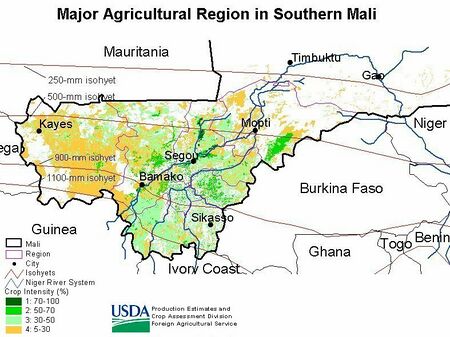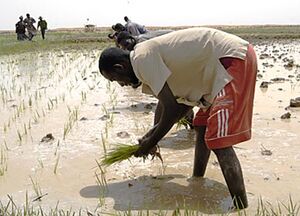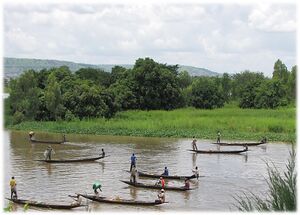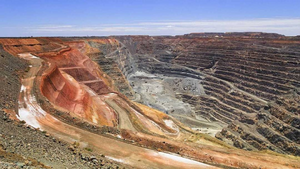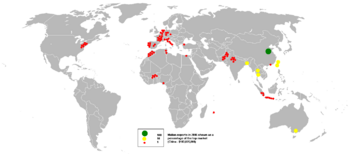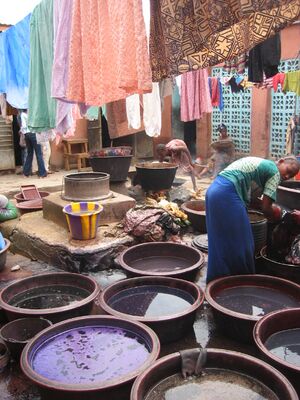اقتصاد دولة مالي
 A pirogue carrying two passengers on the River Niger at Gao in Mali. | |
منظمات التجارة | AU, AfCFTA, WTO, ECOWAS, CEN-SAD |
|---|---|
| احصائيات | |
| ن.م.إ | |
نمو ن.م.إ |
|
ن.م.إ للفرد | |
| 1.734% (2018)[1] | |
| 33.0 medium (2009)[3] | |
| الخارجي | |
| ▲ −$886 million (2017 est.)[5] | |
إجمالي الديون الخارجية | ▲ $4.192 billion (31 December 2017 est.)[5] |
| المالية العامة | |
| ▼ 35.4% of GDP (2017 est.)[5] | |
| العوائد | 3.075 billion (2017 est.)[5] |
| النفقات | 3.513 billion (2017 est.)[5] |
احتياطيات العملات الأجنبية | ▲ $647.8 million (31 December 2017 est.)[5] |
The economy of Mali is based to a large extent upon agriculture, with a mostly rural population engaged in subsistence agriculture.
Mali is among the ten poorest nations of the world, is one of the 37 Heavily Indebted Poor Countries, and is a major recipient of foreign aid from many sources, including multilateral organizations (most significantly the World Bank, the African Development Bank, and Arab Funds), and bilateral programs funded by the European Union, France, the United States, Canada, the Netherlands, and Germany. Before 1991, the former Soviet Union, China and the Warsaw Pact countries had been a major source of economic and military aid.
The per capita gross domestic product (GDP) of Mali was $820 in 1999. Mali's great potential wealth lies in mining and the production of agricultural commodities, livestock, and fish. The most productive agricultural area lies along the banks of the Niger River, the Inner Niger Delta and the southwestern region around Sikasso.
. . . . . . . . . . . . . . . . . . . . . . . . . . . . . . . . . . . . . . . . . . . . . . . . . . . . . . . . . . . . . . . . . . . . . . . . . . . . . . . . . . . . . . . . . . . . . . . . . . . . . . . . . . . . . . . . . . . . . . . . . . . . . . . . . . . . . . . . . . . . . . . . . . . . . . . . . . . . . . . . . . . . . . . .
توجه الاقتصاد الكلي
| السنة | الناتج المحلي الإجمالي | مقابل الدولار | مؤشر التضخم (2000=100) |
|---|---|---|---|
| 1980 | 356,026 | 211.29 فرنك غ.أ. | 48 |
| 1985 | 551,381 | 449.37 فرنك غ.أ. | n.d. |
| 2005 | 2,760,689 | 525.34 فرنك غ.أ. | 111 |
الزراعة
In 2018, Mali produced:[6]
- 3.8 million tons of maize;
- 3.1 million tons of rice;
- 1.8 million tons of millet;
- 1.5 million tons of sorghum;
- 814 thousand tons of mango (15th largest producer in the world);
- 710 thousand tons of cotton (15th largest producer in the world);
- 551 thousand tons of watermelon;
- 522 thousand tons of onion;
- 512 thousand tons of okra;
- 370 thousand tons of sugar cane;
- 368 thousand tons of peanuts;
- 312 thousand tons of sweet potato;
- 303 thousand tons of potato;
- 226 thousand tons of sheanut;
- 215 thousand tons of cowpea;
- 196 thousand tons of banana;
- 167 thousand tons of cashew nuts (8th largest producer in the world);
- 159 thousand tons of beans;
- 159 thousand tons of tomato;
الأرز
السورغم
الماشية
الصيد
الثروات المعدنية والتعدين
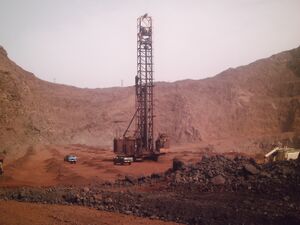
الذهب
الآثار الاجتماعية والبيئية
معادن أخرى
حسب تقدير لشركة Leo Lithium أعلن في يناير 2023، فإنه يمكن تشغيل منجم گولامينا للليثيوم المستقبلي، لأكثر من 23 عامًا بإنتاج سنوي يبلغ 726000 طن. ومن المقرر دخول المنجم حيز الإنتاج في النصف الأول من عام 2024. وقد بدأت أعمال بناء المنجم والمصنع، وتتقدم حسب الجدول الزمني. وبحسب شركة التعدين، زادت الموارد المعدنية في گولامينا بنسبة 31٪ لتصل إلى 142.3 مليون طن بنسبة 1.38٪ من أكسيد الليثيوم. وترتبط هذه الزيادة بأعمال الاستكشاف التي تم إجراؤها بين مايو وأكتوبر 2022 في حقول دانايا، التي تستضيف الآن 56.1 مليون طن بمحتوى أكسيد الليثيوم بنسبة 1.24٪. ويتوافق هذا الرقم الجديد مع زيادة بنسبة 152٪ مقارنة بتقديرات يونيو 2020. ويؤكد التقدير الجديد فوق كل شيء إمكانية تمديد عمر المنجم إلى ما بعد 23 عامًا المتوقعة في الدراسة الجدوى، بفضل حقول دانايا. وكان قد تم تطوير گولامينا في إطار شراكة مع شركة Ganfeng Lithium الصينية والتي وفرت جزءًا من الأموال اللازمة لبناء المنجم، وبالتالي تأمين جزء كبير من الإنتاج المستقبلي لهذا المعدن الضروري لإنتاج بطاريات الليثيوم-أيون للسيارات الكهربائية.[7]
التصنيع
الإصلاح الاقتصادي
. . . . . . . . . . . . . . . . . . . . . . . . . . . . . . . . . . . . . . . . . . . . . . . . . . . . . . . . . . . . . . . . . . . . . . . . . . . . . . . . . . . . . . . . . . . . . . . . . . . . . . . . . . . . . . . . . . . . . . . . . . . . . . . . . . . . . . . . . . . . . . . . . . . . . . . . . . . . . . . . . . . . . . . .
المساعدات الخارجية
إحصائيات
GDP: purchasing power parity – $41.22 billion (2017 est.)
GDP – real growth rate: 5.4% (2017 est.)
GDP – per capita: purchasing power parity – $2,200 (2017 est.)
GDP – composition by sector:
agriculture:
41.8% (2017 est.)
industry:
18.1% (2017 est.)
services:
40.5% (2017 est.)
Population below poverty line: 36.1% (2005 est.)
Household income or consumption by percentage share:
lowest 10%:
2.4% (2001 est.)
highest 10%:
30.2% (2001 est.)
Inflation rate (consumer prices): 1.8% (2017 est.)
Labor force: 6.447 million (2017 est.)
Labor force – by occupation: agriculture and fishing: 80% (2005 est.) industry and services: 20% (2005 est.)
Unemployment rate: 12%
Budget:
revenues:
3.075 billion (2017 est.)
expenditures:
3.513 billion (2017 est.)
Industries: food processing; construction; phosphate and gold mining
Industrial production growth rate: 6.3% (2017 est.)
Electricity – production: 2.489 billion kWh (2016 est.)
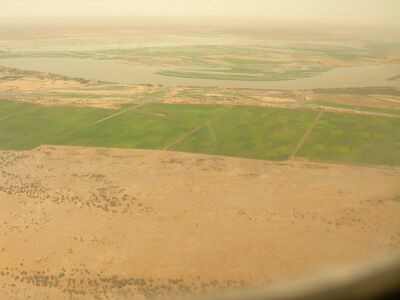
Electricity – production by source:
fossil fuel:
68%
hydro:
31%
nuclear:
0%
other:
1% (2017 est.)
Electricity – consumption: 2.982 billion kWh (2016 est.)
Electricity – exports: 0 kWh (2016 est.)
Electricity – imports: 800 million kWh (2016 est.)
Agriculture – products: cotton, pearl millet, rice, corn, maize, vegetables, peanuts; cattle, sheep, goats
Exports: $3.06 billion (2017 est.)
Exports – commodities: cotton 50%, gold, livestock
Exports – partners: Switzerland 31.8%, UAE 15.4%, Burkina Faso 7.8%, Cote dIvoire 7.3%, South Africa 5%, Bangladesh 4.6% (2017)
Imports: $3.644 billion (2017 est.)
Imports – commodities: petroleum, machinery and equipment, construction materials, foodstuffs, textiles
Imports – partners: Senegal 24.4%, China 13.2%, Cote dIvoire 9%, France 7.3% (2017)
Debt – external: $4.192 billion (31 December 2017 est.)
Economic aid – recipient: $691.5 million (2005)
Currency: 1 Communaute Financiere Africaine franc (CFAF) = 100 centimes
Exchange rates:
Communaute Financiere Africaine francs (CFAF) per US$1 – 647.25 (January 2000), 615.70 (1999), 589.95 (1998), 583.67 (1997), 511.55 (1996), 499.15 (1995)
note:
since 1 January 1999, the CFAF is pegged to the euro at a rate of 655.957 CFA francs per euro
Fiscal year: calendar year
انظر أيضاً
المصادر
- ^ أ ب ت ث ج "World Economic Outlook Database, October 2019". IMF.org. International Monetary Fund. Retrieved 24 November 2019.
- ^ "Global Economic Prospects, June 2019: Heightened Tensions, Subdued Investment. p. 127" (PDF). openknowledge.worldbank.org. World Bank. Retrieved 24 November 2019.
- ^ "GINI index (World Bank estimate) - Mali". data.worldbank.org. World Bank. Retrieved 24 November 2019.
- ^ "Ease of Doing Business in Mali". Doingbusiness.org. Retrieved 2017-01-25.
- ^ أ ب ت ث ج ح "The World Factbook". CIA.gov. Central Intelligence Agency. Retrieved 24 November 2019.
- ^ Mali production in 2018, by FAO
- ^ . مالي مباشر بالعربي https://twitter.com/mali_news_arabi/status/1615771780479856642?t=ww98CPqI2gFMu-kMkWFgvw&s=19&fbclid=IwAR1CW-Gh4XgBO1De575VYyhjHcfu7vshXmr4-sIgAHYgB3WxSMIifgBseEQ.
{{cite web}}: Missing or empty|title=(help)
وصلات خارجية
- اقتصاد دولة مالي at Curlie
- Mineral resources of Mali
- Mali latest trade data on ITC Trade Map
- Mali Market Information: Projet d'Appui au Systéme d'Information Décentralisé du Marché Agricole (PASIDMA).
- OBSERVATOIRE DU MARCHE AGRICOLE: Ministry of Agriculture, Government of Mali.
- Assemblée Permanente des Chambres d'Agriculture du Mali "APCAM": Agricultural cooperatives assembly, Bamako Mali.
- The Quicker Ticker- Mali: A French language investment site for Mali
- West African Agricultural Market Observer/Observatoire du Marché Agricole (RESIMAO), a project of the West-African Market Information Network (WAMIS-NET), provides live market and commodity prices from fifty seven regional and local public agricultural markets across Benin, Burkina Faso, Ivory Coast, Guinea, Niger, Mali, Senegal, Togo, and Nigeria. Sixty commodities are tracked weekly. The project is run by the Benin Ministry of Agriculture, and a number of European, African, and United Nations agencies.
